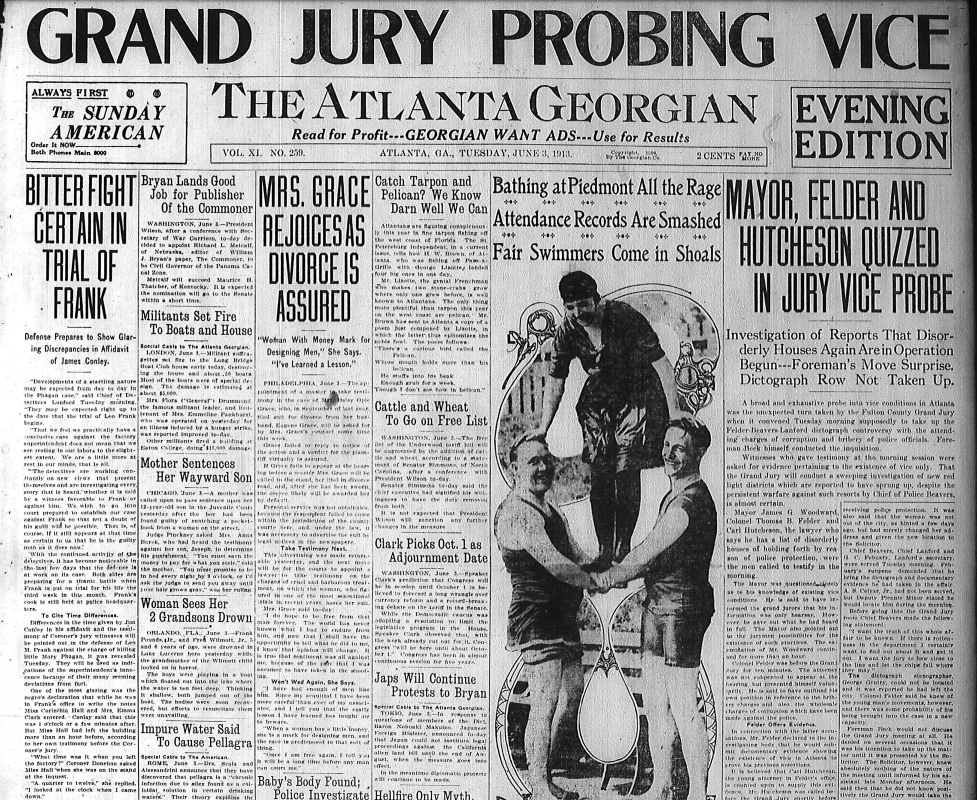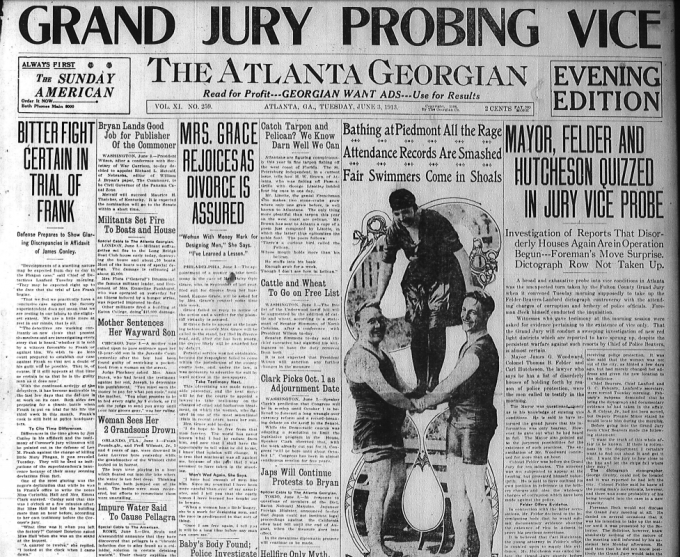Another in our series of new transcriptions of contemporary articles on the Leo Frank case.
Atlanta Georgian
Tuesday, June 3rd, 1913
Defense Prepares to Show Glaring Discrepancies in Affidavit of James Conley.
[Minola McKnight, the negro cook at Frank’s home, made a written statement Tuesday afternoon to the police following a cross-examination lasting more than an hour at the police station.
The woman was questioned by E. H. Pickett and Roy L. Craven, both of whom are employed at the hardware store of Beck & Gregg. While the bearing of her statement on the Phagan case was not revealed, it is generally thought to relate to the actions of Frank and other inmates of his household on the morning following the murder.
She is believed to have stuck to her story that Frank was home at 1:30, which is one link in the alibi chain the defense is forging.
That Louise H. Beck, foreman of the Grand Jury which indicted Frank, is a co-partner in the establishment with which Pickett and Craven, the questioners of the negro woman, are employed is believed to lend much significance to the cross-examination by the two men. This connection, however, was not made public.
The cook was later released after her statement had been taken, and with her husband left for her Pulliam street home. It was said that she might be called as a witness in the trial of Frank. Much as the detectives attempted to shroud her evidence in mystery, all the indications were that she had not materially changed her statement in favor of Frank. She was released on an agreement with her counsel, George Gordon. — added from a later edition of the Georgian — Ed.]
“Developments of a startling nature may be expected from day to day in the Phagan case,” said Chief of Detectives Lanford Tuesday morning. “They may be expected right up to the date that the trial of Leo Frank begins.
“That we feel we practically have a conclusive case against the factory superintendent does not mean that we are resting in our labors to the slightest extent. We are a little more at rest in our minds, that is all.
“The detectives are working constantly on new clews that present themselves and are investigating every story that is heard, whether it is told by a witness favorable to Frank or against him. We wish to go into court prepared to establish our case against Frank so that not a doubt of his guilt will be possible. That is, of course, if it still appears at that time as certain to us that he is the guilty man as it does now.”
With the continued activity of the detectives, it has become noticeable in the last few days that the defense is at work on its case. Both sides are preparing for a titanic battle when Frank is put on trial for his life the third week in this month. Frank’s cook is still held at police headquarters.
To Cite Time Differences.
Differences in the time given by Jim Conley in his affidavit and the testimony of Coroner’s jury witnesses will be pointed out in the defense of Leo M. Frank against the charge of killing little Mary Phagan, it was revealed Tuesday. They will be used as indications of the superintendent’s innocence because of their many seeming deviations from fact.
One of the most glaring was the negro’s declaration that while he was in Frank’s office to write the notes Miss Corinthia Hall and Mrs. Emma Clark entered. Conley said that this was 1 o’clock or a few minutes after. But Miss Hall had left the building more than an hour before, according to her own testimony before the Coroner’s jury.
“What time was it when you left the factory?” Coroner Donehoo asked Miss hall when she was on the stand at the inquest.
“A quarter to twelve,” she replied. “I looked at the clock when I came down.”
The negro said that he looked at the clock when he went in the office and that it was just four minutes of 1 o’clock. He had been in there a few minutes, he asserted, when the voices of Miss Hall and Mrs. Clark were heard.
Another statement which will be refuted is Conley’s declaration that he assisted in taking the body from the second floor down to the basement on the elevator.
To Testify Elevator Didn’t Run.
Two witnesses will be called to prove that the elevator did not run that day at the time the body is said to have been disposed of.
These two witnesses are Harry Denham and Arthur White. They were on the fourth floor from early in the forenoon until after 3 o’clock in the afternoon. If the elevator had been run they say they would have known it. The experiment of running the elevator has been tried since the murder. It is said that it can not be run without the persons on the fourth floor being aware of it.
The theory that will be presented by the defense is that Mary Phagan was the victim of drink-crazed Conley. From his hiding place near the stairs he saw her descending from the second floor. She was alone. He quickly stunned her with a blow over the head, the defense will suggest, and toppled her down the elevator shaft, taking her purse and later disposing of her body.
The alibis which the defense will seek to establish are, of course, the weapons on which reliance will be placed to complete the riddling or Conley’s testimony and affidavits. Frank had arrived home in the afternoon at the time Conley says the superintendent was dictating notes in his office, according to five witnesses the defense will be able to call.
Conley described at length his alleged conversation with Frank in the factory office after 1 o’clock. Frank says that he arrived home for luncheon at 1:20 o’clock and he is supported in his statement by five witnesses.
Seven witnesses are prepared to testify that Frank was home in the evening at the time he is said to have been telephoning to Mrs. Mima [sic] Fo[r]mby, asking for her permission to bring a girl to her house. If the State’s theory is accepted that Mary Phagan was killed in the afternoon, the defense will hold that the Fo[r]mby affidavit is ridiculous on its face. It will be pointed out that any man, whether he be ignorant or intelligent, would not in the first place confide his crime to a negro or any other person by asking their assistance in disposing of the body.
After this he would not take a cab driver, a woman and any others who happened to observe his movements into his confidence by removing the dead body to a semi-public house like that of Mrs. Fo[r]mby’s.
Police to Combat Them.
The element of time will enter into several other phases of the defense to show that the negro has been lying in all his affidavits. He repeated a conversation which took place between Foreman Darley and Miss Mattie Smith. He said that it took place a few minutes before 12 o’clock.
The defense will claim that, as a matter of fact, the conversation took place at about 9:30 o’clock in the morning and that the negro must have been there at that time in order to hear the conversation, although he testified that he did not come there until he met Frank on the street at 11 o’clock. The police, however, are ready to combat testimony along this line.
That Frank would have been satisfied with the incoherent, almost unintelligible notes found beside the girl’s body, if he had been dictating them, will be represented as most unreasonable. The notes were more probably the sole work of a half-intoxicated negro, as Conley has admitted he was, the defense will maintain.
* * *
Atlanta Georgian, June 3rd 1913, “Bitter Fight Certain in Trial of Frank,” Leo Frank case newspaper article series (Original PDF)

